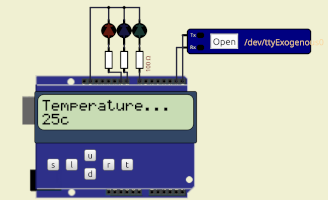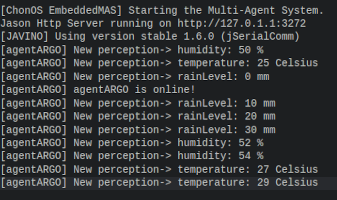-
Notifications
You must be signed in to change notification settings - Fork 0
Arduino LCD Keypad Project
Nilson Lazarin edited this page Sep 30, 2024
·
7 revisions
| Home | Examples | Tools |
|---|
 |
 |
|---|
//serialPort(ttyACM0). /* when using a original arduino board */
//serialPort(ttyUSB0). /* when using a generic arduino board **/
//serialPort(ttyEmulatedPort0). /* when using the simulIDE */
/************************ Initial goals ************************/
!start.
/***************************** Plans ***************************/
+!start: serialPort(P) <-
.argo.port(P);
.argo.limit(1000);
.argo.percepts(open).
-!start: not serialPort(P) <- .print("Without a serialPort belief!").
+!execAction(A) <-
.random(R); .wait(2000*R);
.argo.act(A).
+!infoLCD(Message) <-
.random(R); .wait(2000*R);
.argo.act(Message).
/***************** Perceptions plans *******************/
+rainLast24hrs(R) <- .print("New perception-> rainLevel: ",R," mm").
+humidity(H) <- .print("New perception-> humidity: ",H," %").
+temperature(T) <- .print("New perception-> temperature: ",T," Celsius").
+port(P,S) <- .print("New perception-> Serial port ",P," is ",S).
+device(D): D = arduinoWithLCDKeypadShield <-
.print("Device connected: ",D);
!infoLCD("ARGO online!");
!execAction(greenAlert).| Screenshot | Demonstration |
|---|---|
 |
 |
The low-end IoT device provide the follow perceptions and support the actions below:
device(arduinoWithLCDKeypadShield)[source(percept)]. // the device name
humidity(H)[source(percept)]. // H is a Integer
rainLast24hrs(R)[source(percept)]. // R is a Integer
temperature(T)[source(percept)]. // T is a Integer
.argo.act(redAlert) // turn on the RED LED
.argo.act(yellowAlert) // turn on the YELLOW LED
.argo.act(greenAlert) // turn on the GREEN LED
.argo.act(alertOff) // turn off all LED
.argo.act(M) // print the String M in the LCD Display
#include <Javino.h> //https://github.com/chon-group/javino2arduino
#include <LiquidCrystal.h> //https://www.arduino.cc/reference/en/libraries/liquidcrystal/
// When using a physical arduino boar with the LCD Keypad Shield, uncomment the following:
/*
#define PinLCDCtrl01 4
#define PinLCDCtrl02 5
#define PinLCDCtrl03 6
#define PinLCDCtrl04 7
#define PinLCDRS 8
#define PinLCDEN 9
#define PinLCDLight 10
#define LedRed 11
#define LedYellow 12
#define LedGreen 13
*/
// When using a simulated arduino with the SimulIDE, uncomment the following:
/*
#define PinLCDCtrl01 5
#define PinLCDCtrl02 4
#define PinLCDCtrl03 3
#define PinLCDCtrl04 2
#define PinLCDRS 11
#define PinLCDEN 10
#define PinLCDLight 12
#define LedRed 7
#define LedYellow 8
#define LedGreen 9
*/
Javino javino;
LiquidCrystal lcd(PinLCDRS, PinLCDEN, PinLCDCtrl01, PinLCDCtrl02, PinLCDCtrl03, PinLCDCtrl04);
unsigned long lastClick = millis();
String strBtnPressed = "";
String lastLCDMsg = "";
int option = 0;
int temperature=25;
int airHumidity=50;
int rainLast24hrs=0;
void serialEvent(){
javino.readSerial();
}
void setup() {
pinMode(LedRed,OUTPUT);
pinMode(LedGreen,OUTPUT);
pinMode(LedYellow,OUTPUT);
startLCDWithKeyboard();
javino.start(9600);
}
void loop() {
readLCDKeyboard();
if(javino.availableMsg()){
if(javino.requestPercepts()) getExogenousPerceptions();
else if(javino.requestAction("redAlert")) led("red");
else if(javino.requestAction("yellowAlert")) led("yellow");
else if(javino.requestAction("greenAlert")) led("green");
else if(javino.requestAction("alertOff")) led("off");
else information(javino.getMsg());
}
}
void information(String info){
lastLCDMsg = "";
lcd.clear();
writeInLCD(info);
}
void getExogenousPerceptions(){
javino.addPercept("device(arduinoWithLCDKeypadShield)");
javino.addPercept("humidity("+String(airHumidity)+")");
javino.addPercept("temperature("+String(temperature)+")");
javino.addPercept("rainLast24hrs("+String(rainLast24hrs)+")");
javino.sendPercepts();
}
void startLCDWithKeyboard(){
pinMode(PinLCDLight, OUTPUT);
digitalWrite(PinLCDLight, HIGH);
lcd.begin(16, 2);
printScreen();
}
void readLCDKeyboard(){
strBtnPressed = getBtnPressed();
if((strBtnPressed != "none" ) & (millis()>(lastClick+500))){
lastClick = millis();
if(strBtnPressed == "select") option=0;
else if(strBtnPressed == "down") option++;
else if(strBtnPressed == "up") option--;
printScreen();
}
delay(50);
}
void printScreen(){
if(option<=0){
writeInLCD("Smart Home ...");
writeInLCD(" ");
option=0;
}else if(option==1){
if(strBtnPressed=="right") temperature++;
if(strBtnPressed=="left") temperature--;
writeInLCD("Temperature...");
writeInLCD(String(temperature)+"c");
}else if(option==2){
if(strBtnPressed=="right") airHumidity++;
if(strBtnPressed=="left") airHumidity--;
writeInLCD("Air Humidity");
writeInLCD(String(airHumidity)+"%");
}else if(option>=3){
if(strBtnPressed=="right") rainLast24hrs = rainLast24hrs+5;
if(strBtnPressed=="left") rainLast24hrs = rainLast24hrs-5;
writeInLCD("Rain last 24hrs");
writeInLCD(String(rainLast24hrs)+"mm");
option=3;
}
}
String getBtnPressed(){
int input = analogRead(A0);
if (input < 50) { return "right";}
else if(input < 150){ return "up";}
else if(input < 350){ return "down";}
else if(input < 550){ return "left";}
else if(input < 750){ return "select";}
else return "none";
}
void writeInLCD(String strL){
if (strL.startsWith("\"") && strL.endsWith("\"")) {
strL.remove(0, 1);
strL.remove(strL.length() - 1);
}
int lengthStr = strL.length();
for (int startIndex = 0; startIndex < lengthStr; startIndex += 16) {
int endIndex = startIndex + 15;
if (endIndex >= lengthStr) {
endIndex = lengthStr - 1;
}
String chunk = strL.substring(startIndex, endIndex + 1);
digitalWrite(PinLCDLight, HIGH);
lcd.clear();
lcd.setCursor(0,0);
lcd.print(lastLCDMsg);
lcd.setCursor(0,1);
lcd.print(chunk);
lastLCDMsg = chunk;
}
}
void led(String op){
if(op=="off"){
digitalWrite(LedGreen,LOW);
digitalWrite(LedRed,LOW);
digitalWrite(LedYellow,LOW);
}else if(op=="green"){
led("off");
digitalWrite(LedGreen,HIGH);
}else if(op=="yellow"){
led("off");
digitalWrite(LedYellow,HIGH);
}else if(op=="red"){
led("off");
digitalWrite(LedRed,HIGH);
}
}
- Simulation Project using SimulIDE.
ARGO is licensed under a Creative Commons Attribution 4.0 International License. The licensor cannot revoke these freedoms as long as you follow the license terms:
- Attribution — You must give appropriate credit like below:
Pantoja, C.E., Stabile, M.F., Lazarin, N.M., Sichman, J.S. (2016). ARGO: An Extended Jason Architecture that Facilitates Embedded Robotic Agents Programming. In: Baldoni, M., Müller, J., Nunes, I., Zalila-Wenkstern, R. (eds) Engineering Multi-Agent Systems. EMAS 2016. Lecture Notes in Computer Science(), vol 10093. Springer, Cham. https://doi.org/10.1007/978-3-319-50983-9_8
BibTeX Citation
@InProceedings{ArgoAgent,
author="Pantoja, Carlos Eduardo and Stabile, M{\'a}rcio Fernando and Lazarin, Nilson Mori and Sichman, Jaime Sim{\~a}o",
editor="Baldoni, Matteo and M{\"u}ller, J{\"o}rg P. and Nunes, Ingrid and Zalila-Wenkstern, Rym",
title="{ARGO: An Extended Jason Architecture that Facilitates Embedded Robotic Agents Programming}",
booktitle="Engineering Multi-Agent Systems",
year="2016",
publisher="Springer International Publishing",
address="Cham",
pages="136--155",
isbn="978-3-319-50983-9"
doi="10.1007/978-3-319-50983-9_8"
}
